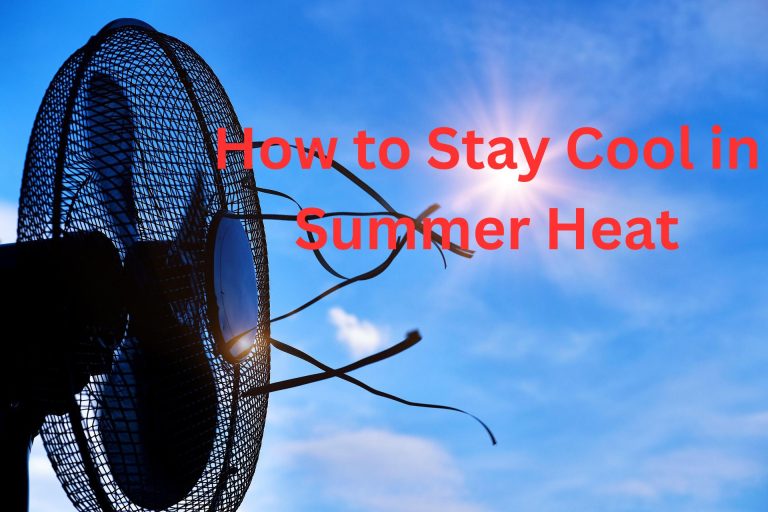When the sun blazes and temperatures soar, Stay Cool in Summer becomes more than a comfort — it’s a health necessity. Whether you’re indoors or out, prolonged exposure to high temperatures can take a toll on your body and energy levels. So how can you keep your cool when summer hits hard? In this guide, we’ll cover simple, smart, and sometimes surprising ways to beat the heat. Beating the summer heat isn’t just about staying comfortable — it’s about safeguarding your health. By staying hydrated, dressing appropriately, eating light, and following these practical tips, you can keep yourself and your loved ones cool, safe, and refreshed, no matter how high the mercury rises.
Why Summer Heat Can Be Dangerous
Risks of Heat Exhaustion
When your body overheats, it struggles to regulate its temperature, leading to heat exhaustion. Symptoms include heavy sweating, dizziness, nausea, and weakness. If left untreated, it can turn into heatstroke — a life-threatening condition.
Heatstroke and Its Symptoms
Heatstroke happens when your body temperature rises above 104°F (40°C). It can cause confusion, rapid heartbeat, unconsciousness, and in severe cases, organ failure. Immediate medical help is essential.
Dehydration Concerns
Hot weather increases the risk of dehydration as your body loses fluids through sweat. Dehydration can cause headaches, dry mouth, fatigue, and disorientation — making it vital to stay hydrated.
Staying Cool Indoors
Use Fans and Air Conditioning Wisely
While air conditioning is the go-to solution, it’s not always available or affordable. Use ceiling fans to circulate cool air, and place a bowl of ice in front of a fan for an instant DIY air cooler.
Keep Curtains and Blinds Closed
Block direct sunlight by closing curtains or blinds during the hottest parts of the day. Blackout curtains work wonders in preventing indoor heat buildup.
Create Cross-Ventilation
Open windows on opposite sides of your home in the evening or early morning to allow cooler air to flow through and push warm air out.
Smart Hydration Tips
Drink Plenty of Water
The golden rule is to sip water throughout the day, not just when you’re thirsty. Aim for at least 8–10 glasses, and more if you’re active.
Avoid Sugary and Caffeinated Drinks
Sodas, energy drinks, and too much coffee can dehydrate you further. Instead, go for water, herbal teas, or fresh fruit juices.
Try Natural Hydrating Foods
Fruits like watermelon, cucumber, oranges, and strawberries are rich in water content and electrolytes that help keep your body cool.
Dress Light and Comfortable
Choose Breathable Fabrics
Natural fabrics like cotton, linen, and bamboo allow your skin to breathe and reduce sweating.
Opt for Light Colors
Dark colors absorb heat, while light shades like white, beige, and pastels reflect it, keeping you cooler.
Wear Hats and Sunglasses
A wide-brimmed hat shields your face and neck from direct sunlight, while UV-protection sunglasses protect your eyes.
Cooling Techniques for Your Body
Take Cold Showers
A quick cold shower not only refreshes you but also lowers your core body temperature effectively.
Use Wet Towels or Cooling Cloths
Drape a damp, cold cloth around your neck, wrists, or forehead for immediate relief.
Apply Ice Packs to Pressure Points
Target areas like your wrists, ankles, and neck with ice packs or cold compresses to cool your blood circulation faster.
Eat Light and Fresh Meals
Avoid Heavy and Greasy Foods
Rich, fried foods can make you feel sluggish and raise your body temperature. Stick to light, easily digestible meals.
Include Water-Rich Fruits and Veggies
Salads, smoothies, and fruit bowls loaded with hydrating ingredients can satisfy your hunger without heating you up.
Stay Away from Spicy Dishes
While spices can induce sweating (a natural cooling method), too much can also increase discomfort in extreme heat.
Outdoor Precautions
Plan Activities for Early Morning or Evening
The sun’s rays are strongest between 11 a.m. and 4 p.m. Schedule outdoor chores and workouts in the cooler parts of the day.
Seek Shade Whenever Possible
If you have to be outdoors, stick to shaded areas under trees, awnings, or umbrellas.
Wear Sunscreen Regularly
Apply a broad-spectrum sunscreen with at least SPF 30 before heading outside. Reapply every two hours.
Sleep Comfortably During Hot Nights
Use Light Bedding
Swap thick blankets for lightweight cotton sheets to allow better airflow.
Cool Your Pillow
Keep your pillowcase in the freezer for a few minutes before bedtime for a refreshing sensation.
Sleep in Loose Cotton Clothing
Avoid synthetic fabrics and choose loose, breathable sleepwear to stay cool and sweat-free.
Best Cooling Gadgets for Summer
Portable Fans
USB-powered fans and mini desk fans offer personal cooling wherever you go — whether you’re at your desk, in bed, or outdoors.
Cooling Gel Pads
Placing gel pads under your pillow or on your seat can bring down body heat during sleep or long sitting hours.
USB Neck Fans
Wearable fans around your neck provide a constant, personal breeze, ideal for commuting and outdoor festivals.
Natural Remedies to Beat the Heat
Peppermint Sprays
A spritz of peppermint-infused water cools the skin instantly and leaves a fresh scent.
Aloe Vera Gel for Cooling
Known for its soothing properties, chilled aloe vera gel provides relief from sunburn and body heat.
Cucumber Face Masks
Cucumbers reduce puffiness and have a cooling effect on tired, overheated skin.
Staying Safe for Vulnerable Groups
Infants and Toddlers
Dress them in light cotton clothes, keep them in shaded areas, and offer water frequently.
Elderly Care in Summer
Ensure seniors stay hydrated, avoid midday outings, and rest in cool rooms.
Pets Need Cooling Too
Give pets access to fresh water, shaded resting spots, and avoid taking them out during peak heat.
Signs of Heat-Related Illness and When to Get Help
Watch out for symptoms like excessive sweating, fainting, rapid pulse, nausea, and confusion. If someone exhibits these signs, move them to a cooler area, hydrate them, and seek medical assistance immediately if symptoms persist.


